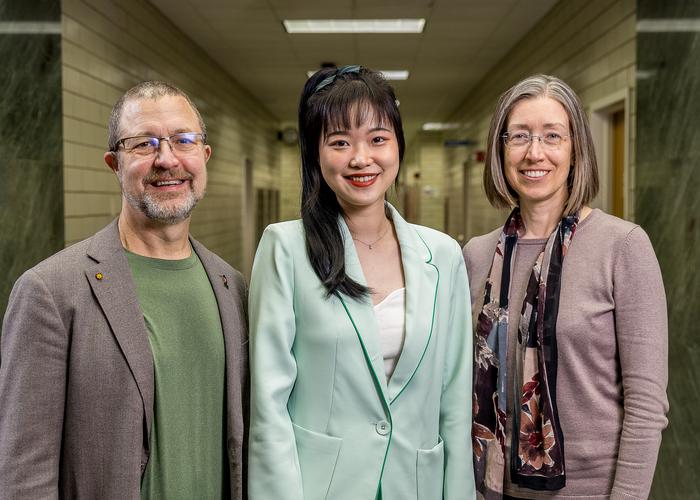MADISON — In an effort to improve delivery of costly medical treatments, a team of researchers in electrical engineering at the University of Wisconsin–Madison has developed a stimulating method that could make the human body more receptive to certain gene therapies.

Credit: Photo by Joel Hallberg/UW–Madison
MADISON — In an effort to improve delivery of costly medical treatments, a team of researchers in electrical engineering at the University of Wisconsin–Madison has developed a stimulating method that could make the human body more receptive to certain gene therapies.
The researchers exposed liver cells to short electric pulses — and those gentle zaps caused the liver cells to take in more than 40 times the amount of gene therapy material compared to cells that were not exposed to pulsed electric fields. The method could help reduce the dosage needed for these treatments, making them much safer and more affordable. The research appears April 30 in the journal PLOS ONE.
Gene therapy is a promising medical technology: By replacing, altering or introducing new genetic material into a patient’s cells, doctors may be able to cure or compensate for genetic diseases, including cystic fibrosis, sickle-cell disease, hemophilia and diabetes.
One of the bottlenecks in gene therapy, however, is getting the right dose of genetic material into the target cells. The UW–Madison research suggests that applying a moderate electric field, which left no lasting damage to the cells that received it, could help in creating more effective therapies.
The project began almost a decade ago with Hans Sollinger, a world-renowned transplant surgeon at UW–Madison. He had developed a gene therapy treatment for Type 1 diabetes, an autoimmune disease that attacks the pancreas, the organ that produces insulin.
Sollinger’s treatment strategy delivered the genetic code for insulin production into liver cells using an adreno-associated virus that assists in transporting the therapeutic genes across the cells’ membrane. This DNA can then take up residence in liver cells, producing insulin without being attacked by the immune system in the pancreas.
While Sollinger had a proof of concept that the therapy worked, he believed the future of the treatment hinged on delivery. He turned to Susan Hagness and John Booske, both UW–Madison professors of electrical and computer engineering who have experience treating human cells with electrical pulses.
“What we started talking about was local, targeted delivery and whether there was a way of getting the treatment DNA directly into the liver without passing it through the entire body and triggering the immune system,” says Hagness. “And whether we could use electric pulses in order to make this delivery process more efficient and dramatically reduce the dose needed.”
Researchers have previously found that exposing cells to electric fields can often increase the ability of molecules to move through the cell membrane into the interior of a cell. So, in this latest study, PhD student Yizhou Yao sought to determine whether the technique would increase the penetration of virus particles into liver cells.
Using human hepatoma cells, a model system for studying the liver, Yao exposed batches of the cells to various concentrations of the gene therapy virus particles containing a fluorescent green protein. She used a pair of electrodes to deliver an 80-millisecond electric pulse to some samples, then incubated all the cells for 12 hours.
When she examined the results 48 hours later under a fluorescence microscope, Yao found that only a small percentage of the cells that had not received the electrical pulses glowed green. In stark contrast, those cells that had received a zap accumulated about 40 times the amount of the fluorescent green proteins delivered by the virus.
While results provided compelling evidence that the pulses helped facilitate the virus’s penetration of the cell walls, Booske says the team has yet to discover exactly how the process works at the molecular level.
“There’s enough known about electric pulsing that I think we could confidently state that it is opening nanopores through the cell membrane,” he says. “But then Yao got this remarkable result, and it dawned on us that virus particles are in general bigger and more complex than bare molecular particles and they already have their own way of getting inside cells. So, we don’t really know if it’s the pores opening that has anything to do with it directly or indirectly.”
Sollinger passed away in May 2023, but the team says his legacy will live on through the ongoing research on this project and the work of other groups. The electrical engineering researchers are pursuing next steps with external funding and are optimistic that ultimately the technique will translate into clinical trials.
Yao, who will graduate in 2024, says she knew the study would be transdisciplinary, but didn’t realize just how far it would go.
“I am an electrical engineer by training, and I don’t have a biology background,” she says. “Before this, the last time I used a microscope was in high school. It was quite a steep learning curve, learning to culture cells and carry out biology protocols. But I really enjoyed this project and liked its ultimate goal, which is to make the world a better place.”
Other authors include Robert W. Holdcraft of the Cincinnati Children’s Hospital Medical Center.
Journal
PLoS ONE
Method of Research
Experimental study
Subject of Research
Cells



